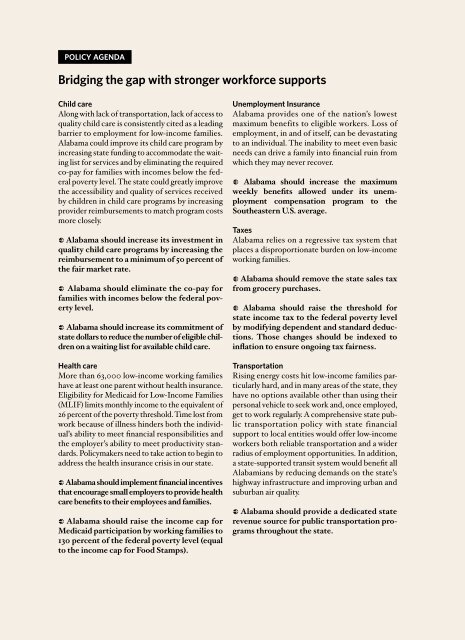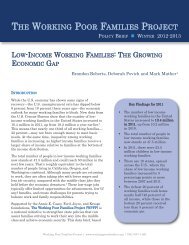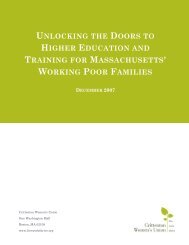alabama's working families and the broken promise of economic ...
alabama's working families and the broken promise of economic ...
alabama's working families and the broken promise of economic ...
- No tags were found...
Create successful ePaper yourself
Turn your PDF publications into a flip-book with our unique Google optimized e-Paper software.
POLICY AGENDABridging <strong>the</strong> gap with stronger workforce supportsChild careAlong with lack <strong>of</strong> transportation, lack <strong>of</strong> access toquality child care is consistently cited as a leadingbarrier to employment for low-income <strong>families</strong>.Alabama could improve its child care program byincreasing state funding to accommodate <strong>the</strong> waitinglist for services <strong>and</strong> by eliminating <strong>the</strong> requiredco-pay for <strong>families</strong> with incomes below <strong>the</strong> federalpoverty level. The state could greatly improve<strong>the</strong> accessibility <strong>and</strong> quality <strong>of</strong> services receivedby children in child care programs by increasingprovider reimbursements to match program costsmore closely.[ Alabama should increase its investment inquality child care programs by increasing <strong>the</strong>reimbursement to a minimum <strong>of</strong> 50 percent <strong>of</strong><strong>the</strong> fair market rate.[ Alabama should eliminate <strong>the</strong> co-pay for<strong>families</strong> with incomes below <strong>the</strong> federal povertylevel.[ Alabama should increase its commitment <strong>of</strong>state dollars to reduce <strong>the</strong> number <strong>of</strong> eligible childrenon a waiting list for available child care.Health careMore than 63,000 low-income <strong>working</strong> <strong>families</strong>have at least one parent without health insurance.Eligibility for Medicaid for Low-Income Families(MLIF) limits monthly income to <strong>the</strong> equivalent <strong>of</strong>26 percent <strong>of</strong> <strong>the</strong> poverty threshold. Time lost fromwork because <strong>of</strong> illness hinders both <strong>the</strong> individual’sability to meet financial responsibilities <strong>and</strong><strong>the</strong> employer’s ability to meet productivity st<strong>and</strong>ards.Policymakers need to take action to begin toaddress <strong>the</strong> health insurance crisis in our state.[ Alabama should implement financial incentivesthat encourage small employers to provide healthcare benefits to <strong>the</strong>ir employees <strong>and</strong> <strong>families</strong>.[ Alabama should raise <strong>the</strong> income cap forMedicaid participation by <strong>working</strong> <strong>families</strong> to130 percent <strong>of</strong> <strong>the</strong> federal poverty level (equalto <strong>the</strong> income cap for Food Stamps).Unemployment InsuranceAlabama provides one <strong>of</strong> <strong>the</strong> nation’s lowestmaximum benefits to eligible workers. Loss <strong>of</strong>employment, in <strong>and</strong> <strong>of</strong> itself, can be devastatingto an individual. The inability to meet even basicneeds can drive a family into financial ruin fromwhich <strong>the</strong>y may never recover.[ Alabama should increase <strong>the</strong> maximumweekly benefits allowed under its unemploymentcompensation program to <strong>the</strong>Sou<strong>the</strong>astern U.S. average.TaxesAlabama relies on a regressive tax system thatplaces a disproportionate burden on low-income<strong>working</strong> <strong>families</strong>.[ Alabama should remove <strong>the</strong> state sales taxfrom grocery purchases.[ Alabama should raise <strong>the</strong> threshold forstate income tax to <strong>the</strong> federal poverty levelby modifying dependent <strong>and</strong> st<strong>and</strong>ard deductions.Those changes should be indexed toinflation to ensure ongoing tax fairness.TransportationRising energy costs hit low-income <strong>families</strong> particularlyhard, <strong>and</strong> in many areas <strong>of</strong> <strong>the</strong> state, <strong>the</strong>yhave no options available o<strong>the</strong>r than using <strong>the</strong>irpersonal vehicle to seek work <strong>and</strong>, once employed,get to work regularly. A comprehensive state publictransportation policy with state financialsupport to local entities would <strong>of</strong>fer low-incomeworkers both reliable transportation <strong>and</strong> a widerradius <strong>of</strong> employment opportunities. In addition,a state-supported transit system would benefit allAlabamians by reducing dem<strong>and</strong>s on <strong>the</strong> state’shighway infrastructure <strong>and</strong> improving urban <strong>and</strong>suburban air quality.[ Alabama should provide a dedicated staterevenue source for public transportation programsthroughout <strong>the</strong> state.Alabama’s Working Families 37







